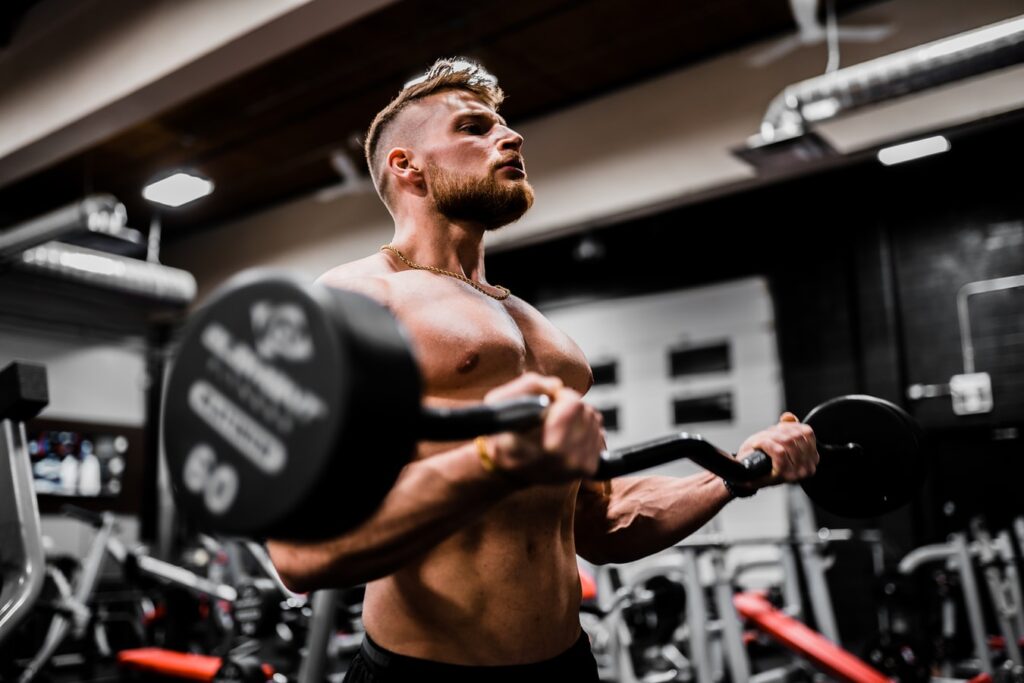Fasted training – what’s the deal with that?
Ever since intermittent fasting took the world of fitness by storm, thousands of people have begun lifting weights and doing cardio in a fasted state.
The theory is, training fasted is more beneficial – both for our fitness results and health.
But how true is that? What does research have to say on the matter? And, more importantly, can we safely lift weights while fasted?
Let’s find out.
So, can You Lift Weights While Fasting?
The short answer: yes, pretty much.
The long answer:
We can do a lot of things in a fasted state, and lifting weights is one of them. Just because you’re fasted, doesn’t mean that you’re unable to exert effort and have productive workouts.
There is something to keep in mind, though.
When training in a fasted state, you’re at an increased risk of muscle loss due to the lack of readily available nutrients that typically come from previous meals (1).
So, if you want to train fasted, it’s a good idea to either have about ten grams of BCAAs before or during your workout or have a high-protein meal after you’re done lifting weights.
For example, if you follow the 16:8 intermittent fasting protocol and usually break your fast around 12 or 1 at noon, you should avoid early-morning workouts because you’ll then have to spend several hours in a highly-catabolic state. Instead, train at around 11 AM and then immediately have your first meal of the day.
What Does It Mean to Fast?
In case you’re wondering what exactly it means to be fasted, let’s review that quickly.
Being in a fasted state means that your insulin is at baseline.
Once we’ve had a meal, we enter what is known as the postprandial state, which can last for up to eight hours while the body digests the food we’ve eaten and absorbs its nutrients (2). After that, we enter what is known as the postabsorptive state, which lasts for several more hours as the body slowly goes into the fasted state (3).
While fasting, the body’s ability to burn fat is improved, primarily thanks to the low insulin levels. Of course, the long-term fat loss still depends on the number of calories we consume. But, fasting makes fat mobilization and oxidation much easier.
What are the Risks of Fasted training?
As good as it sounds, fasted training does offer some minor risks. But, so long as you’re aware of them ahead of time, you should be fine.
The risks of fasted training are, increased risk of muscle loss and decreased training performance. Both of these risks are directly associated with not having any calories / energy readily available for processing. When we lift weights, we are expending energy. If you don’t have the energy available, in the form of food, you are likely going to be weaker and run out of energy faster. When we use energy, but don’t have it available, our bodies may turn to energy stored in the form of muscle and fat to provide the energy for our workout.
The risk of muscle loss is higher.
When training in a fasted state, the risk of proteolysis (muscle protein breakdown) tends to be higher (1).
This is primarily because the body doesn’t have an immediate supply of energy, and, as the workout progresses, the body burns more fat and muscle tissue to get the energy it needs.
Rates of proteolysis are also higher after the workout is over, which is why it’s crucial to have a post-workout meal as soon as possible (4, 5).
Decreased training performance.
Many people find that training in a fasted state is much more difficult for them due to the lack of immediate energy (6).
So, if you’ve always trained fed (after a couple of meals and maybe even a snack), you are likely to find yourself weaker. Of course, the human body has this incredible ability to adapt, so your performance will pick up. But, according to research, it takes about three weeks for that to happen (7).
So, if you plan on training fasted, be aware that you’ll likely have to decrease the weights a bit – at least temporarily.
Does Fasted Training Have Benefits?
With the risks out of the way, let’s now take a look at some of the positives.
The primary benefit of fasted training is increased fat burning potential. Not only is it possible to burn more fat during fasted training but it is possible to burn more “stubborn fat” which is categorized as fat with low blood flow, especially around our mid sections. When the body has no energy from food, it will need to take energy from somewhere to allow us to push through our workout. Ideally, we will use stored fat as that energy source. Fasting increases blood flow to the abdominal region. This, in theory, will allow the “stubborn fat” to be more readily mobilized and burned.
Increased fat-burning.
Research suggests that training fasted increases fat-burning (8). In other words, the body uses more fat for energy and less glucose.
There are likely two mechanisms at play here. First, we have the fact that the body more easily burns fat due to the low insulin levels and 2nd….

It may help burn “stubborn fat.”
If you’re a human being (which I assume you are), no matter how easy it may be for you to burn fat and stay lean, there is a good chance that you have some areas covered with stubborn fat. For men, this tends to be around the stomach and love handle area. For women, it’s usually around the thighs, hips, and butt.
Unlike normal adipose tissue, stubborn fat is characterized by the high number of alpha receptors (which reduce fat-burning) when compared to beta receptors (which encourage fat-burning) (9, 10). The more alpha receptors adipose tissue has, the more resistant it is to releasing its fatty acids for energy.
Stubborn fat also has a worse blood supply, which makes it even more difficult for the body to burn it. This is because, for beta receptors to release their fatty acids, they need to interact with catecholamines such as norepinephrine. Due to the reduced blood flow there, fat-burning hormones don’t have an opportunity to travel to the fat cells.
The good news is, it appears that fasted training may stimulate blood flow to the abdominal region, which is the area where most people hold stubborn fat (11).
So, by training fasted, you can improve your body’s ability to utilize stubborn fat and use it for energy.
There’s no risk of stomach distress.
Training after having a couple of meals carries the risk of stomach distress. And, if you have a particularly sensitive stomach, I’m sure you can attest to this, especially if you’ve ever had some dairy in the hours before training (12).
The great thing about fasted training is that it helps prevent discomfort, nausea, and indigestion because there is no food in your stomach.
Another factor here is your unique ability to tolerate carbohydrates. Some folks find themselves tired, moody, and lazy after having a carb-rich meal. There is also an inherent feeling of ‘heaviness’ in the stomach.
This can impact your ability to exert yourself in the gym. In that case, ironically enough, pre-workouts carbs would hinder performance, rather than improve it.
So, training fasted might be a great way to prevent the adverse effects of carbs – the heavy feel in your stomach, brain fog, lethargy, and an overall lack of motivation.
How to Minimize the Negatives of Fasted Training?
As we mentioned above, there are two primary negatives of fasted training – decreased performance and increased risk of muscle loss (1, 6).
You can’t do much about the first one – your body simply needs some time to adjust, and there isn’t anything you can do to speed up the process. All you can do is accept the fact that your performance will take a temporary hit, but you can rest assured that it will pick up within three weeks.
To reduce muscle loss during fasted training you should:
- Take some BCAAS or EAAS before your workout. That won’t kick you out of the fasted state, but it will provide your body with some amino acids that will help slow down the breakdown of muscle.
- Have a protein-rich post-workout meal as soon as you can. This is by far your best option when it comes to preventing muscle loss.
My Own Personal Experience with Fasted Training
I used intermittent fasting, calorie restriction, and heavy training to diet down from 280 to 205. I lost 75 lbs in a span of 2 years (summer of 2016 – summer of 2018) During that time, I trained fasted a lot and for the most part, I liked it.
Further Reading: Check out my “about me” page for more info on my weight loss / transformation.
I liked the “light” feeling of having a completely empty stomach. I had plenty of energy and generally felt good. I didn’t “feel” that my performance was hindered.
Intermittent fasting worked well for me. It was one of the weapons in my shed (that’s the saying right) that allowed me to get in the best shape of my life.
That being said, I don’t use intermittent fasting anymore. Before, my primary focus was losing weight at all costs. Now, my primary focus is maximizing what I have. At the time of writing this, I am in a cutting phase but my goal is to lose 5-10 lbs and not 75. Also, I want to be sure I keep every bit of muscle I have.
Now that my bulk weight loss is over, I prefer training in a “fed” state. It seems that I am able to push harder and get more aggressive when I am in a “fed” state vs fasted. Also, if there is any chance that fed training will lead to more muscle growth or muscle retained during a cut, it’s worth it to me to train in a fed state.
Do you like to train fasted or fed? Why? Please leave a comment….. and then go Pump Some Iron!
Follow me / Pump Some Iron on Instagram for updates @pump.some.iron

